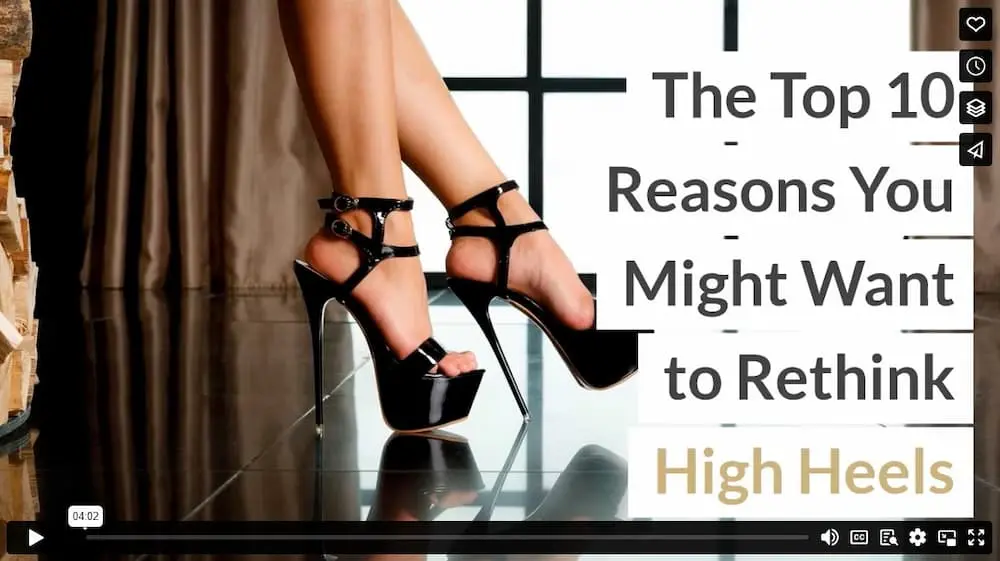High heels are the pinnacle of femininity, the apex of womanhood, the peak of beauty.
And beauty is pain, right?
Well, they got the pain part right.
While high heels do accentuate a woman’s beauty, they can also do a number to their feet. The design of high heels compresses your feet unnaturally onto the balls of your feet. This strained pressure can create a wide range of problems.
Here are ten potential problems that can come from excessive high-heel use.
1. Morton’s Neuroma.
A neuroma is nerve damage, resulting in either a thickened nerve or a benign tumor on the nerve. This phenomenon can feel like a pebble stuck in your shoe, sharpness, burning, tingling, or numbness. The pain is felt in the small area between the third and fourth toes. Morton’s neuroma can develop because of the pressure from high heels.
2. Bunions.
The unnatural compression of the toes, particularly in high heels with a narrow toe box, leaves little room for the big toe to fit comfortably. The base of the toe can begin to jut out, resulting in a bunion.
3. Hammertoes.
Hammertoe is a condition where a toe has an unnatural bend in one of the toe joints. This is caused by narrow toe boxes in shoes and, of course, high heels scrunching feet together more than normal. A hammertoe can be stiff, difficult to move, swollen, and painful. Correction for hammertoes without surgery is possible and includes custom orthotics, physical therapy, and footwear modification.
4. Achilles Tendonitis.
Wearing high heels excessively can lead to a stiff and shortened Achilles tendon. A compromised Achilles tendon is more susceptible to developing Achilles tendonitis.
5. Corns.
Hardened sections of skin on the tops and sides of the toes are corns. Similar to a callus, a corn creates a thick, flaky, dry spot on your foot. Unlike a callus, however, corns are typically painful to the touch.
6. Metatarsalgia.
Burning or sharp pain in the ball of your foot is categorized as metatarsalgia. It can also make your toes numb or tingly. Untreated metatarsalgia can start affecting other areas of your feet, too. It can even start creating pain in other parts of your body as you try to compensate for the pain in your feet.
7. Stress Fractures.
Tiny cracks in the bone are called stress fractures. These are most common in the weight-bearing bones of your lower legs or feet. Stress fractures occur in weakened bones that are exposed to repetitive stress, which can be caused by all your weight being compressed into the balls of your feet. Stress fracture pain gets worse over time.
8. Sprains.
The higher your heel, the greater chance you have of spraining your ankle. High heels shift your center of balance, which can render their wearer a little more wobbly than with flat feet.
9. Plantar Fasciitis.
The plantar fascia is a band of connective tissue that runs along the bottom and arch of the foot. When injured, it can swell, causing a condition known as plantar fasciitis. Plantar fasciitis is known for its heel pain, but the pain can be in the arch of the foot as well.
10. Pump Bump.
Haglund’s Syndrome, also known as a pump bump, develops from constant pressure on the back of the heel. This pressure can come from a stiff-backed high heel, which is where the nickname “pump bump” derived from. This bump is a bony protrusion that accompanies a swollen bursa sac. The area is painful and inflamed.
Hip, Knee, and Back Pain.
In addition to these potential foot issues, high heels can also be damaging to the rest of your body.
The angles your body holds itself when you wear high heels are not their natural poses. Contouring your body to stay upright and balanced comes with consequences; excessive high heel use can lead to problems in your hips, knees, and lower back. This pain can become chronic with excessive heel-wearing, and it can even lead to arthritis.
If you can’t cut out heels completely, consider making a couple of adjustments to your footwear. Lowering the height of your heel by even an inch can make a big difference in the amount of damage to your feet. Choosing heels with open toes or a large toe box can also help prevent your feet from scrunching unnaturally within the heel.
If, however, all of this pain seems worth the price of beauty to you, just make sure you keep a “foot specialist near me” search on your phone handy.
Video

Infographic
High heels are often seen as the epitome of femininity and beauty, but they can also cause various foot problems due to the unnatural pressure they exert on the feet. Check out this infographic that outlines ten potential issues associated with excessive high-heel use.




